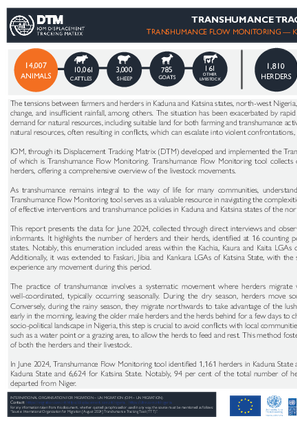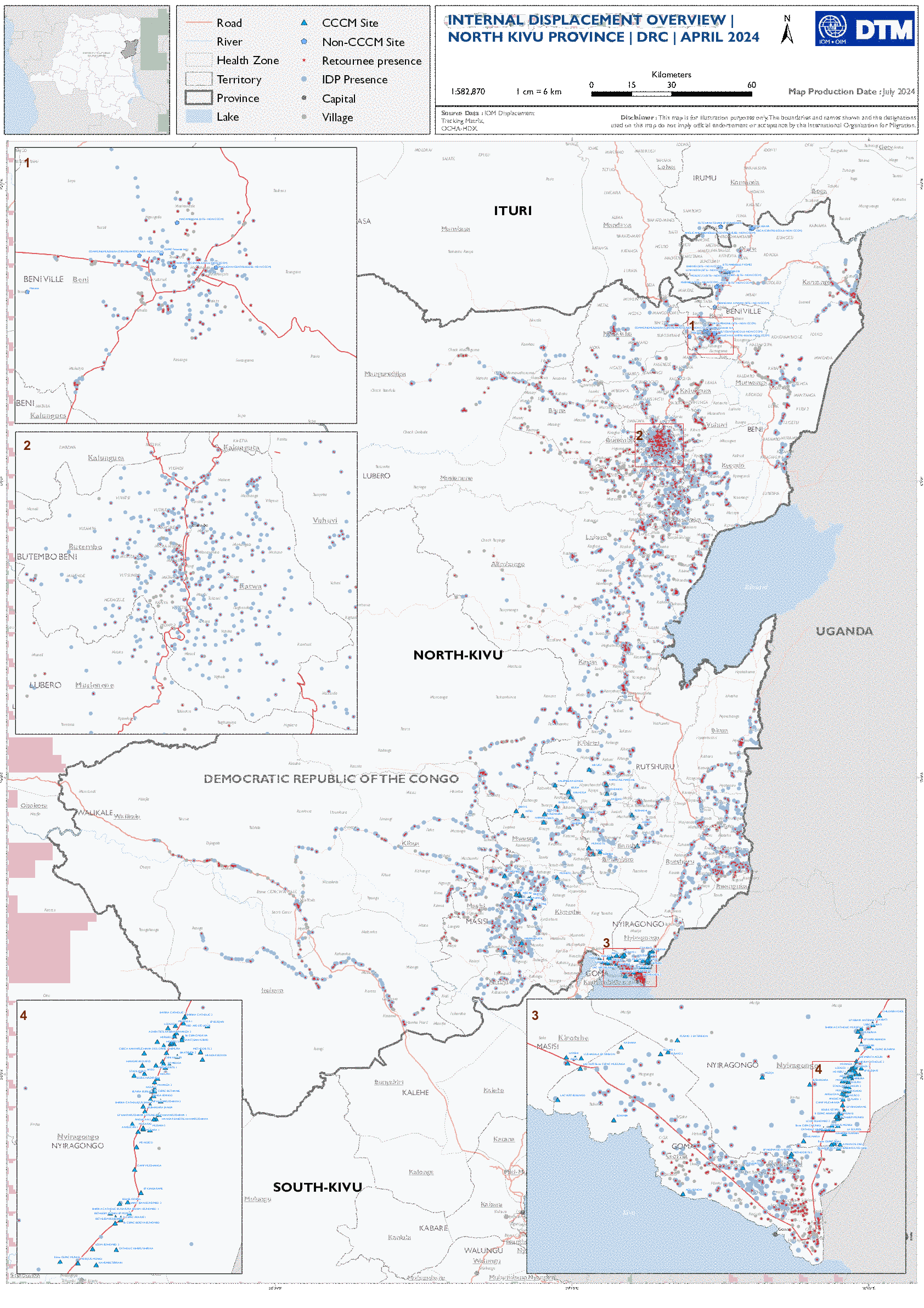-
Countries
-
Data and Analysis
-
Special Focus
-
Crisis Responses
Mobility Tracking
Mobility Tracking Round 11 visualisation of internal displacement in the province of North Kivu.
Mobility Tracking Round 11 visualisation of internal displacement in the province of Ituri.

Contact
DTM Somalia, IOMSomaliaDTM@iom.int
Language
English
Location
Somalia
Period Covered
Aug 10 2024
Aug 14 2024
Activity
- Mobility Tracking
- Baseline Assessment
This latest round of Emergency Trends Tracking was initiated in April 2024 to monitor displacements movements during the Gu rainy season. Districts covered in this round include Afgooye, Afmadow, Baardheere, Baidoa, Balcad, Belet Weyne, Belet Xaawo, Cabudwaaq, Dayniile, Dhuusamarreeb, Doolow, Gaalkacyo, Garoowe, Hodan, Jamaame, Jowhar, Kahda, Kismaayo, and Luuq. ETT is a crisis-based tool that tracks sudden displacement triggered by specific events or emerging crises.
The objective of ETT is to help prioritize humanitarian response and to enable partners to deliver rapid assistance. Based on previous shock induced displacement patterns, the humanitarian community expects that people will continue to move toward urban areas in search of humanitarian services. Consequently, the ETT coverage focuses on the main urban centers and surrounding villages for each assessed district. The data is collected through Key Informant Interviews (KIIs) at the location level, from Sunday to Wednesday every week. It includes information on new arrivals, numbers and demographic of IDPs, reasons for displacement, intentions, humanitarian assistance and priority needs among others.
To facilitate the joint analysis of the CCCM (Camp Coordination and Camp Management) Cluster’s New Arrivals Tracker (NAT) and ETT data, the assistance and needs indicators are identical in both tools.
Contact
dtmlebanon@iom.int
Location
Lebanon
Activity
- Flow Monitoring
- Mobility Tracking
- Migrants presence
Period Covered
May 14 2024 -Jul 17 2024
The MPM assessment follows the methodology of IOM’s global Displacement Tracking Matrix (DTM) Mobility Tracking component. Tailored to the operational context in Lebanon, the MPM assessment analyzes data to provide multi-layered information on the presence and mobility of migrants. This assessment aims to complement existing data collection exercises and it is implemented in coordination with key actors to maximize synergies, interoperability and avoid duplication.
Aggregated data is available through the DTM API: https://dtm.iom.int/data-and-analysis/dtm-api
A more detailed version of this dataset is available, to get access kindly click on the 'Request Access' button
Population Groups
Migrants Present
Survey Methodology
Unit of Analysis Or Observation
Admin Area 2
Admin Area 3
Individual
Type of Survey or Assessment
Key Informant
Keywords
Geographical Scope Full Coverage
Administrative boundaries with available data
The current dataset covers the following administrative boundaries

Contact
dtmlebanon@iom.int
Language
English
Location
Lebanon
Period Covered
May 14 2024
Jul 17 2024
Activity
- Mobility Tracking
- Baseline Assessment
- Migrants presence
This report presents the findings of the Migrant Presence Monitoring (MPM) data collection exercise conducted by IOM in Lebanon from May to July 2024, covering all districts. The MPM is an annual assessment that aims to determine the number of migrants present in different areas of Lebanon to support humanitarian assistance and planning efforts. To ensure accurate data, the MPM relies on key informants (KIs), such as representatives from migrant communities, local leaders (mukhtars), and municipal officials. This year, recruitment agencies were also included as KIs to enhance data reliability in their respective areas. The assessment focuses on small areas to gather detailed and precise information. It not only categorizes migrants by nationality, sex, and age but also considers their living situations, distinguishing between “live-in” and “live-out” migrants. Overall, the MPM provides valuable insights into the migrant population in Lebanon, contributing to informed decision-making and effective support for those in need.
The information from IOM-MPM's findings, complementary to data from past assessments, aims to enable partners across the international community and Lebanese partners to have access to an evidence base on migrant presence, to support well-informed, targeted, and coordinated response. The complementary evidence generated from the MPM exercise also serves as a baseline and tertiary source for triangulation for other data collection exercises. For example, MPM data was used to develop of a sampling frame of migrants for the Multi-Sectorial Needs Assessment (MSNA) 2021, 2022 and 2023 exercises led by the Humanitarian Country Team (HCT).
The MPM assessment follows the methodology of IOM’s global Displacement Tracking Matrix (DTM) Mobility Tracking component. Tailored to the operational context in Lebanon, the MPM assessment analyzes data to provide multi-layered information on the presence and mobility of migrants. This assessment aims to complement existing data collection exercises and it is implemented in coordination with key actors to maximize synergies, interoperability and avoid duplication.

Contact
DTM Sudan; dtmsudan@iom.int
Language
English
Location
Sudan
Period Covered
Aug 01 2024
Aug 18 2024
Activity
- Mobility Tracking
- Baseline Assessment
This report reflects data corresponding to Sudan Mobility Update (6) dataset. The dataset is available here.
Overview:
This report provides an overview of the total population of internally displaced persons (IDPs) in Sudan, including those displaced both before and after the onset of the conflict on 15 April 2023.
Key Findings:
- An estimated total of 10,763,116 IDPs were displaced to 8,842 locations, in 183 localities, across all 18 states in Sudan.
- An estimated 7,987,783 individuals were displaced internally within Sudan since 15 April 2023.
- An estimated 27 per cent of IDPs who were initially displaced prior to the onset of the current conflict experienced secondary displacement since 15 April 2023.
- Approximately 2,316,538 individuals crossed borders into neighbouring countries since 15 April 2023.
- The top states of origin among IDPs were Khartoum (34%), South Darfur (19%), and North Darfur (14%).
- The states hosting the most IDPs were South Darfur (17%), North Darfur (15%) and Gedaref (9%).
- Over half (52%) of IDPs were reportedly children under the age of 18-years-old.
Annex 1 includes an operational matrix with a table of estimated IDPs per state, disaggregated by displacement before versus after 15 April 2023.
Note: The number of IDPs displaced post 15 April 2023 (7,9987,783 IDPs) includes the estimated 1,045,439 IDPs who were initially displaced prior to 15 April 2023 and experienced secondary displacement since 15 April 2023. DTM Sudan defines an internally displaced person as any person who has been forced or obliged to flee from their habitual residence due to an event dating from 2003 onwards.

Contact
DTM Nigeria, AllUsersInDTMNigeria@iom.int
Language
English
Location
Nigeria
Period Covered
Jun 01 2024
Jun 30 2024
Activity
- Flow Monitoring
- Flow Monitoring Registry
- Mobility Tracking
- Transhumance Tracking Tool
This report presents the data for June 2024, collected through direct interviews and observations by DTM enumerators which were triangulated via a network of key informants. It highlights the number of herders and their herds, identified at 16 counting points in the six Local Government Areas (LGAs) across Kaduna and Katsina states. Notably, this enumeration included areas within the Kachia, Kaura and Kaita LGAs of Kaduna and Katsina states, under the auspices of the Peacebuilding Fund. Additionally, it was extended to Faskari, Jibia and Kankara LGAs of Katsina State, with the support of the European Union Fund. Batsari and Dan Musa LGAs did not experience any movement during this period.
In June 2024, Transhumance Flow Monitoring tool identified 1,161 herders in Kaduna State and 649 herders in Katsina State. The herd count was estimated at 7,383 for Kaduna State and 6,624 for Katsina State. Notably, 94 per cent of the total number of herders departed from states within Nigeria, while the remaining 6 per cent departed from Niger.
Contact
ISSDTM@iom.int
Location
South Sudan
Activity
- Survey
- Mobility Tracking
Period Covered
Aug 09 2024 -Aug 10 2024
According to the headcount conducted on August 10, 2024, the Malakal TC hosts 1,498 individuals (1,474 South Sudanese returnees, 19 Sudanese nationals, and 5 other nationals), showing a decrease of 1,521 individuals compared to April 2024.
Population Groups
IDPs
Returnee (Previously Displaced Abroad)
Returnee (Previously Internally Displaced)
Survey Methodology
Unit of Analysis Or Observation
Site or Location
Type of Survey or Assessment
Household
Keywords
Geographical Scope Partial Coverage
Administrative boundaries with available data
The current dataset covers the following administrative boundaries
Contact
ISSDTM@iom.int
Location
South Sudan
Activity
- Survey
- Mobility Tracking
Period Covered
Jul 07 2024 -Jul 11 2024
On the 7th of July 2024, IOM Displacement Tracking Matrix (DTM) conducted a rapid intention survey covering Renk TC 1, 2 and TC-Extension. A total of 10,735 individuals (8,130 returnees and 2,605 refugees) were reported to be present at the Renk TC while 652 households were sampled to be interviewed with the vast majority of respondents being South Sudanese (99.8%).
Population Groups
IDPs
Returnee (Previously Displaced Abroad)
Returnee (Previously Internally Displaced)
Survey Methodology
Unit of Analysis Or Observation
Site or Location
Type of Survey or Assessment
Household
Keywords
Geographical Scope Partial Coverage
Administrative boundaries with available data
The current dataset covers the following administrative boundaries

Contact
DTM Support — iomdrcdtm@iom.int
Language
French
Location
Democratic Republic of the Congo
Period Covered
Aug 06 2024
Aug 10 2024
Activity
- Mobility Tracking
- Event Tracking
L’évaluation rapide de l’OIM (Suivi des Urgences) est un outil mis en place dans le but de collecter des informations sur les mouvements importants et soudains des populations. Ces informations sont collectées à la suite de visites terrain et/ou d’entretiens téléphoniques avec les informateurs clé des sites de déplacement ou des communautés d’accueil. Les informations sont ensuite recueillies dans les outils Évaluation Rapide Multisectorielle (ERM). Ce rapport synthétique présente les résultats des évaluations réalisées du 06 – 10 août 2024 à travers des évaluations menées sur terrain avec les informateurs clé. Evaluation réalisée lors d’entretiens téléphonique avec des informateurs clé.
En date du 29 juillet 2024, les affrontements ont eu lieu entre les groupes armés Forces armées de la République démocratique du Congo (FARDC) et Twa dans le village de Tumbwe Koki et dans le site de Kantambo (tous les deux dans le groupement de Tumbwe Fief, dans la chefferie de Tumbwe, dans le territoire de Kalemie, province du Tanganyika). À cause des affrontements, la population des villages directement touchés (Tumbwe Koki, Nkosa, Chai, et camp Kantambo) a préventivement déplacé vers les villages Mapanda, Kawama Mulwanyi, Likasi et Kasama (2 530 individus, soit 506 ménages). Les personnes déplacées sont actuellement hébergées en familles d’accueil,
dans un site spontané (dans Kasama) ou les centres collectifs : l’église 8eme Communauté des Églises Pentecôtistes en Afrique Centrale (CEPAC) à Mapanda et Communauté des Églises Pentecôtistes au Congo (CEPECO) à Kawama.
Pagination
- Previous page
- Page 36
- Next page


